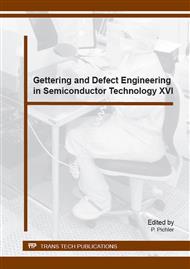[1]
A. D. Compaan, Photovoltaics: clean power for the 21st century, Solar Energy Mater. and Solar Cells, vol. 90, no. 15, pp.2170-2180, (2006).
DOI: 10.1016/j.solmat.2006.02.017
Google Scholar
[2]
J. F. Nijs, J. Szlufcik, J. Poortmans, S. Sivoththaman, and R. P. Mertens, Advanced manufacturing concepts for crystalline silicon solar cells, IEEE Trans. Electron Devices, vol. 46, no. 10, pp.1948-1969, (1999).
DOI: 10.1109/16.791983
Google Scholar
[3]
S. Myers, M. Seibt, and W. Schr¨oter, Mechanisms of transition-metal gettering in silicon, J. Appl. Phys., vol. 88, no. 7, p.3795, (2000).
Google Scholar
[4]
J. Reiss, R. King, and K. Mitchell, Characterization of diffusion length degradation in czochralski silicon solar cells, Appl. Phys. Lett., vol. 68, no. 23, pp.3302-3304, (1996).
DOI: 10.1063/1.116581
Google Scholar
[5]
A. A. Istratov, T. Buonassisi, R. McDonald, A. Smith, R. Schindler, J. Rand, J. P. Kalejs, and E. R. Weber, Metal content of multicrystalline silicon for solar cells and its impact on minority carrier diffusion length, J. Appl. Phys., vol. 94, no. 10, pp.6552-6559, (2003).
DOI: 10.1063/1.1618912
Google Scholar
[6]
A. Istratov, H. Hieslmair, and E. Weber, Iron contamination in silicon technology, Appl. Phys. A, vol. 70, no. 5, pp.489-534, (2000).
DOI: 10.1007/s003390051074
Google Scholar
[7]
R. Raghunathan, E. Johlin, and J. C. Grossman, Grain boundary engineering for improved thin silicon photovoltaics, Nano Letters, vol. 14, no. 9, pp.4943-4950, (2014).
DOI: 10.1021/nl501020q
Google Scholar
[8]
M. Rumler, M. Rommel, J. Erlekampf, M. Azizi, T. Geiger, A. J. Bauer, E. Meißner, and L. Frey, Characterization of grain boundaries in multicrystalline silicon with high lateral resolution using conductive atomic force microscopy, J. Appl. Phys., vol. 112, no. 3, p.034909, (2012).
DOI: 10.1063/1.4746742
Google Scholar
[9]
A. Y. Liu and D. Macdonald, Precipitation of interstitial iron in multicrystalline silicon, Solid State Phenomena, vol. 205, pp.34-39, (2014).
DOI: 10.4028/www.scientific.net/ssp.205-206.34
Google Scholar
[10]
J. Zhang, C. -Z. Wang, and K. -M. Ho, "Finding the low-energy structures of si.
Google Scholar
[1]
symmetric tilted grain boundaries with a genetic algorithm, " Phys. Rev. B, vol. 80, no. 17, p.174102, (2009).
Google Scholar
[11]
F. Cleri, P. Keblinski, L. Colombo, S. R. Phillpot, and D. Wolf, Correlation between atomic structure and localized gap states in silicon grain boundaries, Phys. Rev. B, vol. 57, no. 11, p.6247, (1998).
DOI: 10.1103/physrevb.57.6247
Google Scholar
[12]
K. Kutsukake, N. Usami, K. Fujiwara, Y. Nose, and K. Nakajima, Influence of structural imperfection of Σ5 grain boundaries in bulk multicrystalline si on their electrical activities, J. Appl. Phys., vol. 101, no. 6, pp.063-063509, (2007).
DOI: 10.1063/1.2710348
Google Scholar
[13]
J. Chen, T. Sekiguchi, D. Yang, F. Yin, K. Kido, and S. Tsurekawa, Electron-beam-induced current study of grain boundaries in multicrystalline silicon, J. Appl. Phys., vol. 96, no. 10, pp.5490-5495, (2004).
DOI: 10.1063/1.1797548
Google Scholar
[14]
R. Jones and P. R. Briddon, The ab initio cluster method and the dynamics of defects in semiconductors, ser. Semiconductors and Semimetals. Boston: Academic Press, 1998, vol. 51A, ch. 6.
DOI: 10.1016/s0080-8784(08)63058-6
Google Scholar
[15]
O. A. Al-Ani, J. P. Goss, N. E. B. Cowern, P. R. Briddon, M. Al-Hadidi, R. Al-Hamadany, and M. J. Rayson, A density functional study of iron segregation at isfs and Σ5-(001) GBs in mc-Si, GADEST 2015, Sept (2015).
DOI: 10.4028/www.scientific.net/ssp.242.224
Google Scholar
[16]
C. J. Fall, R. Jones, P. R. Briddon, A. T. Blumenau, T. Frauenheim, and M. I. Heggie, Influence of dislocations on electron energy-loss spectra in gallium nitride, Phys. Rev. B, vol. 65, no. 24, p.245304, (2002).
DOI: 10.1103/physrevb.65.245304
Google Scholar
[17]
C. J. Fall, A. T. Blumenau, R. Jones, P. R. Briddon, T. Frauenheim, A. Guti´errez-Sosa, U. Bangert, A. E. Mora, J. W. Steeds, and J. E. Butler, Dislocations in diamond: Electron energy-loss spectroscopy, Phys. Rev. B, vol. 65, no. 20, p.205206, (2002).
DOI: 10.1103/physrevb.65.205206
Google Scholar
[18]
T. C. A. D. Sentaurus, Synopsys Inc., edition I-2013. 12, (2013).
Google Scholar
[19]
F. Bouchard, A. W. Walker, Z. Mi, and K. Hinzer, Modeling a monocrystalline Cu(In, Ga)Se2 single junction solar cell grown on a GaAs substrate, Proc. SPIE, vol. 8915, p.891507, (2013).
DOI: 10.1117/12.2036189
Google Scholar


